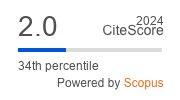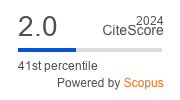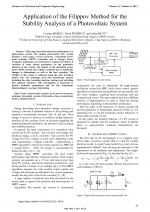| 4/2011 - 15 |
Application of the Filippov Method for the Stability Analysis of a Photovoltaic SystemMOREL, C. |
| Extra paper information in |
| Click to see author's profile in |
| Download PDF |
Author keywords
photovoltaic systems, dc-dc power converters, nonlinear dynamical systems, bifurcation, chaos, monodromy matrix, saltation matrix
References keywords
power(7), tracking(6), solar(6), point(6), photovoltaic(6), morel(5), maximum(5), energy(5), systems(4)
Blue keywords are present in both the references section and the paper title.
About this article
Date of Publication: 2011-11-30
Volume 11, Issue 4, Year 2011, On page(s): 93 - 98
ISSN: 1582-7445, e-ISSN: 1844-7600
Digital Object Identifier: 10.4316/AECE.2011.04015
Web of Science Accession Number: 000297764500015
SCOPUS ID: 84856619753
Abstract
This paper describes bifurcation phenomena of a photovoltaic system. The studied photovoltaic (PV) system includes a solar panel, a boost converter, a maximum power point tracking (MPPT) controller and a storage device. Computer simulations are performed to capture the effects of variation of some chosen parameters on the qualitative behavior of the system. The impact of the maximum power point (MPP) current and voltage variations due to luminosity changes is determinate, as well as the load variation. The stability of the system is analyzed using the state transition matrix over one switching cycle (the monodromy matrix) including the state transition matrices during each switching (the saltation matrices). This investigation is important to predict nonlinear phenomena and for the components dimensioning for a proper functioning. |
| References | | | Cited By «-- Click to see who has cited this paper |
| [1] W. Xiao, N. Ozog, and W. G. Dunford, "Topology Study of Photovoltaic Interface for Maximum Power Point Tracking", IEEE Transactions on Industrial Electronics, vol. 54, no. 3, pp. 1696-1704, 2007. [CrossRef] [SCOPUS Times Cited 537] [2] M. J. Vasallo Vazquez, J. M. Andujar Marquez, and F. S. Manzano, "A Methodology for Optimizing Stand-Alone PV-System Size Using Parallel-Connected DC/DC Converters", IEEE Transactions on Industrial Electronics, vol. 55, no. 7, pp. 2664-2673, 2008. [CrossRef] [SCOPUS Times Cited 82] [3] D. Petreus, D. Moga, A. Rusu, T. Patarau, M. Munteanu, "Photovoltaic System with Smart Tracking of the Optimal Working Point", Advances in Electrical and Computer Engineering, vol. 10, no. 3, pp. 40-47, 2010. [CrossRef] [Full Text] [SCOPUS Times Cited 10] [4] D. Petreus, T. Patarau, S. Daraban, C. Morel, B. Morley, "A Novel Maximum Power Point Tracker Based on Analog and Digital Control Loops", Solar Energy, vol. 85, pp.588-600, 2011. [CrossRef] [SCOPUS Times Cited 36] [5] V. Salas, E. Olias, A. Barrado, and A. Lazaro, "Review of the maximum power point tracking algorithms for stand-alone photovoltaic systems", Solar Energy Materials and Solar Cells, vol. 90, pp. 1555-1578, 2006. [CrossRef] [SCOPUS Times Cited 1093] [6] A. Pandey, N. Dasgupta and A. K. Mukerjee, "High-Performance Algorithms for Drift Avoidance and Fast Tracking in Solar MPPT System", IEEE Transactions on Energy Conversion, vol. 23, no. 2, 2008. [CrossRef] [SCOPUS Times Cited 292] [7] T. Esram, P. L. Chapman, "Comparison of Photovoltaic Array Maximum Power Point Tracking Techniques", IEEE Transactions on Energy Conversion, vol. 22, no. 2, pp. 439 - 449, 2007. [CrossRef] [SCOPUS Times Cited 4603] [8] Z. Wujian, L. Qiuhua et al, "Survey of Maximum Power Point Tracking Techniques for Photovoltaic Array", High Voltage Engineering, Vol.34, No.6, pp.1145-1154, 2008. [9] C. Morel, R. Vlad, J-Y. Morel, "Anticontrol of Chaos Reduces Spectral Emissions", Journal of Computational and Nonlinear Dynamics, vol. 3, pp. 041009-1, 2008. [CrossRef] [SCOPUS Times Cited 13] [10] C. Morel, M. Bourcerie, F. Chapeau-Blondeau, "Generating independent chaotic attractors by chaos anticontrol in nonlinear circuits", Chaos, Solitons and Fractals, vol. 26, pp. 541, 2005. [CrossRef] [SCOPUS Times Cited 13] [11] C. Morel, R. Vlad, E. Chauveau, "A new technique to generate independent periodic attractors in the state space of nonlinear dynamic systems", Nonlinear Dynamics, vol. 59, pp. 45, 2009. [CrossRef] [SCOPUS Times Cited 9] [12] M. G. Villalva, J. R. Gazoli, E. Ruppert F., "Comprehensive approach to modeling and simulation of photovoltaic arrays", IEEE Transactions on Power Electronics, vol. 25, no. 5, pp. 1198 - 1208, 2009. [CrossRef] [SCOPUS Times Cited 3808] [13] D. Giaouris, S. Banerjee, B. Zahawi, V. Pickert, "Stability analysis of the continuous-conduction-mode Buck converter via Filippov's method", IEEE Transaction on Circuits and Systems, vol. 55, no.4, 2008. [CrossRef] [SCOPUS Times Cited 208] [14] D. Giaouris, S. Banerjee, B. Zahawi, V. Pickert, "Control of fast scale bifurcations in power-factor correction converters", IEEE Transaction on Circuits and Systems, vol. 54, no.9, 2007. [CrossRef] [SCOPUS Times Cited 69] [15] D. Giaouris, S. Maity, S. Banerjee, B. Zahawi, V. Pickert, "Application of Filippov method for the analysis of subharmonic instability in dc-dc converters", International Journal of Circuit Theory and Applications, vol. 37, 2009. [CrossRef] [16] M. Suri, T.A. Huld, E. D. Dunlop, H. A. Ossenbrink, 2007, "Potential of solar electricity generation in the European Union member states and candidate countries", Solar Energy, 81, 1295-1305, [CrossRef] [SCOPUS Times Cited 561] Web of Science® Citations for all references: 0 SCOPUS® Citations for all references: 11,334 TCR Web of Science® Average Citations per reference: 0 SCOPUS® Average Citations per reference: 708 ACR TCR = Total Citations for References / ACR = Average Citations per Reference We introduced in 2010 - for the first time in scientific publishing, the term "References Weight", as a quantitative indication of the quality ... Read more Citations for references updated on 2025-06-30 22:25 in 101 seconds. Note1: Web of Science® is a registered trademark of Clarivate Analytics. Note2: SCOPUS® is a registered trademark of Elsevier B.V. Disclaimer: All queries to the respective databases were made by using the DOI record of every reference (where available). Due to technical problems beyond our control, the information is not always accurate. Please use the CrossRef link to visit the respective publisher site. |
Faculty of Electrical Engineering and Computer Science
Stefan cel Mare University of Suceava, Romania
All rights reserved: Advances in Electrical and Computer Engineering is a registered trademark of the Stefan cel Mare University of Suceava. No part of this publication may be reproduced, stored in a retrieval system, photocopied, recorded or archived, without the written permission from the Editor. When authors submit their papers for publication, they agree that the copyright for their article be transferred to the Faculty of Electrical Engineering and Computer Science, Stefan cel Mare University of Suceava, Romania, if and only if the articles are accepted for publication. The copyright covers the exclusive rights to reproduce and distribute the article, including reprints and translations.
Permission for other use: The copyright owner's consent does not extend to copying for general distribution, for promotion, for creating new works, or for resale. Specific written permission must be obtained from the Editor for such copying. Direct linking to files hosted on this website is strictly prohibited.
Disclaimer: Whilst every effort is made by the publishers and editorial board to see that no inaccurate or misleading data, opinions or statements appear in this journal, they wish to make it clear that all information and opinions formulated in the articles, as well as linguistic accuracy, are the sole responsibility of the author.



